
This chronology of the Selkirk Settlement and more detailed information provide a framework to assist teachers and their students to track the historic events that are marked by the celebration of the Bicentenary of the Selkirk Settlement in 2012. In addition, A Visit With The People of the Red River, A Young Person’s Guide and Resource Book by C. Barry McPherson and Judy McPherson has a valuable Time Line on pages viii and ix.
Grade five teachers may find the chronology helpful for review of what was learned in Grade 4. Can your students place the most significant events on a blank time line? Or perhaps a KWL brainstorming session would help you identify what your students know and guide your planning.
The courage and fortitude of the Selkirk Settlers makes for a gripping and inspiring story that can capture the imagination of your students, inspire their sense of citizenship and pride, and enhance their understanding of the experiences of refugees and new immigrants in their communities. Their story begins with the injustice of the highland clearances and Lord Selkirk’s vision, and includes challenges from the harsh climate, hostility to the settlement from many in the fur trade industry, and leaders whose judgment was not always wise. But it also features the generosity of Chief Peguis and the compassion and support of friends and neighbors far from their homelands. The amazing conclusion of this story is the successful establishment of the first permanent agricultural settlement in British North America. We hope the information and activities that follow will provide opportunities to explore each of these facets of their story, expanding children’s awareness of the history, but also of how it connects to their lives.
In recent years immigration to Manitoba has soared. Many classrooms throughout the province have children who have recently arrived from far away lands. And many other children have moved at least once to a new home or neighborhood or city. In this context an exploration of why and how people move and why they choose the place they move to can become a vibrant cross cultural experience. This is also a good starting point for a study of the Red River Selkirk Settlement since students will soon discover that, in spite of the passage of time and the very different world that is today’s Manitoba, there are parallels between the immigrant experiences of the Selkirk Settlers and those of today.
Explore with children the reasons why people move and why people choose the place they move to. A discussion or brainstorming activity might incorporate these questions. Perhaps you can engage children with their personal experiences and then expand to include their school, neighborhood, city, province and country.
- Have any of you moved recently?
- What do you think might be the reasons people move?
- What are the good things and the bad about being here? (in this neighborhood, this province, this country)
- What do you think new people might find strange about being here?
- What are some of the challenges that newcomers might face?
 |
The Last of the Clan
|
To understand why the Scots left their homeland early in the 19th century to immigrate to the wilderness of Canada it is important to be aware of the Highland Clearances. A more complete discussion of the clearances with reference to opposing views about it is here. This immense movement of people had a profound impact on the culture and economy of the highlands and created a Scottish Diaspora throughout the new world which today vastly outnumbers the population of Scotland itself.
Beginning in the mid-18th century and lasting for more than 100 years, thousands of Scottish highlanders were forced to abandon the land their families had farmed for many generations, by landlords who sought greater economic gain from new agricultural processes. As a result large numbers of Scottish highlanders were forced into very poor coastal villages or the newly industrialized cities as workers in the mills and factories. As well many immigrated to the new world looking for opportunities to rebuild their lives in places where they would be free from the exploitation of the ruling elites.
However, not all of the people recruited by Lord Selkirk were from the Highlands of Scotland. Lord Selkirk’s Settlers also included immigrants from Ireland and Switzerland, and decommissioned members of the De Meurons from Germany. Many of the Irish left the settlement under pressure from the Northwest Company in 1815 and many of the Swiss and German settlers left for the United States after the great flood of 1826. Further information is in this article, published in 1885 by the MHS. If teachers use this source with students it will be important to forewarn them of the prejudice towards the Métis expressed in the article, which is typical of the class and culture of the writer, in that period.
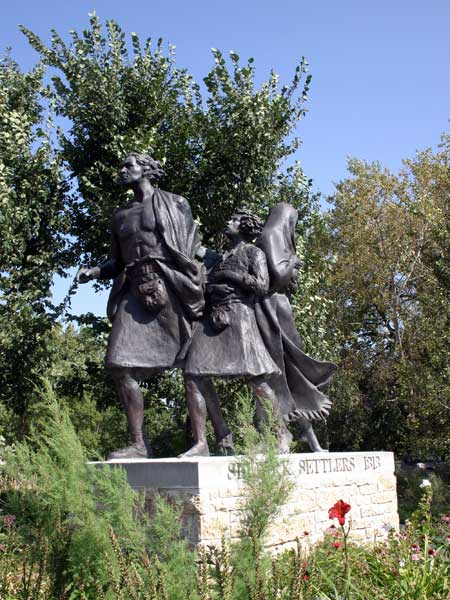 |
Selkirk Settlers Monument
|
You can invite children to investigate why the settlers left their homeland with this interactive website produced by the BBC. Join Callum on a trip into Scotland’s past and find out what happened to his clan during the Highland Clearances. The website has well organized and helpful Teachers’ Notes. It was developed to supplement the Scottish curriculum and offers more activities than you may want to use. However, an extensive outline will allow teachers to pick and choose with relative ease.
Thomas Douglas, the Fifth Earl of Selkirk (1770-1820) left an indelible mark on Canadian history. Born in Scotland to a wealthy family he was well educated and much influenced by the Scottish Enlightenment and the French Revolution. During a visit to the Scottish highlands in 1792 he was moved by the poverty and desperation of tenant farmers who were the victims of the Highland Clearances.
Lord Selkirk developed a plan for a settlement in the Red River valley. He believed that there, farmers displaced by the Clearances would be given an opportunity for a new start in life. He persuaded the Hudson Bay Company’s directors that an agricultural settlement would lower the company’s costs because local farmers would produce goods that until then had been transported into the territory at great expense. Thomas Douglas’ vision of a new colony at the centre of North America led to the eventual end of the economic dominance of the fur trade and began the demographic and social transformation of western Canada.
Lord Selkirk’s vision presents an opportunity to explore with children the issue of philanthropy:
Children can be challenged to think about helping others with these questions which lead to an exploration of why Lord Selkirk cared about the people affected by the Highland Clearances and why he thought helping them move to Canada would be a good thing.
Do you know people who give help to others?
How do you help others?
Why do people want to help others?
Why do you think Lord Selkirk cared about the people who were being forced from their farms in the highlands?
Further investigation of Lord Selkirk’s philanthropy could include a reading of this article by Elizabeth Henderson published in the Manitoba Historical Society’s Manitoba Pageant. It tells the story of a meeting the colonists had with Lord Selkirk during his only visit to the colony in 1817. The article also comments on Lord Selkirk’s relationship with Chief Peguis.
Students might be encouraged to read or listen to the article and respond with their observations about the people and this event in a response journal. Teachers might also find it useful to use a DRTA to guide their students through reading and/or listening to this passage. A suggested DRTA discussion outline for this article is available here.
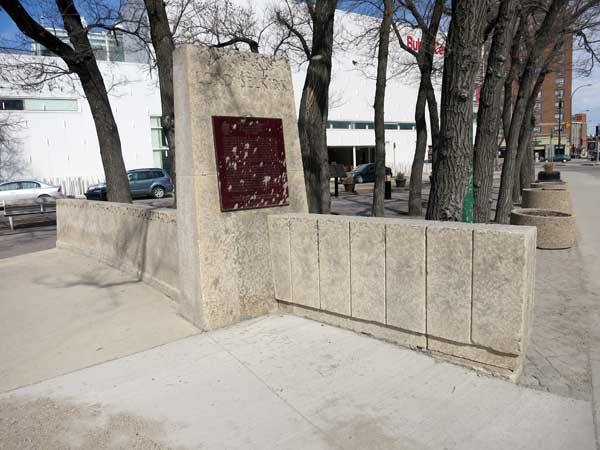 |
Lord Selkirk Monument
|
The importance of Lord Selkirk’s contributions to Winnipeg and Manitoba are honored, among other places, by this commemorative plaque. Street names that honor him include Douglas Avenue, Point Douglas Avenue, and Selkirk Avenue. As well Lord Selkirk School is named for him and a plaque that commemorates Fort Daer tells more of Selkirk’s story.
Teachers may want to encourage students to look for information about Thomas Douglas by following these links, and locating the plaques and streets on a map. If they developed a personal map as part of the mapping activities in What’s in a Name, they could situate these new locations on that map.
In the context of looking for these commemorative sites, your students may be intrigued by the observation that Lord Selkirk seems to have more than one name. Why does he have more than one name? Which is his “real” name and which is his title?
The current Lord Selkirk is James Douglas-Hamilton, Baron Selkirk of Douglas. Students can be challenged to investigate why he is a Baron and not an Earl. Can they infer from this information which title has a higher rank? Why did he disclaim his title as the 11th Earl of Selkirk? The Right Honourable Lord Selkirk of Douglas, PC, QC will visit Winnipeg in the first week of September, 2012 and will take part in several public events during his visit.
Images at http://wn.com/Baron_Selkirk_of_Douglas
Student’s curiosity may be aroused with this activity which personalizes the settlers’ experience. The activity can begin with a discussion tied to children’s own experience with the difference between needs and wants. From this initial discussion a brainstorming session could develop a list of things the settlers might take with them on their voyage to the new world. Working in small groups, children can be asked to categorize the list according to needs and wants and to share and defend their lists in a whole class activity. Or they can be challenged to work collaboratively to identify just a few things to pack for the voyage. Children might report their results with a simple list, or more challengingly, with a skit that re-enacts a family’s experience with organizing and packing for the journey.
The Pioneer Explorations of ‘Scotch Boy” John Tod is an extensive website for children that tells the story of the fur trade through the eyes of John Tod, a pioneer fur trader and one of British Columbia’s founding citizens. Tod journeyed to Hudson Bay on the Edward and Anne in 1811, expecting to travel to the Red River with MacDonnell’s work party. Children will enjoy reading Voyage to Hudson Bay which describes Tod’s journey and includes excerpts from his diary and illustrations of the ship and the icebergs.
The resources that follow provide opportunities for children to explore the people and events that defined the Red River Selkirk Settlement through different media. A television documentary, historical fiction, historical articles and original sources present their lives with drama and color that will surely intrigue many of your students.
Along the way, children will become more aware of issues such as the hostility of many in the fur trade who feared the presence of an agricultural settlement would disrupt their business, the poor judgment of some leaders in both the settlement and the fur trade which led to incidents like the Pemmican Proclamation and the Seven Oaks event, and the fear and prejudice occasioned by beliefs brought from the old country that aboriginal people were less than human because they were not Christians. At the same time, with their teachers’ guidance, children’s understanding of such values as tolerance for religious and cultural differences, hard work and honesty, and mutual support and sharing will be reinforced.
Though produced a decade ago, the CBC television series Canada: a Peoples’ History remains popular with teachers because of the effectiveness of its story telling and the wealth of teaching tools that accompany it. With engaging re-enactments, the series tells Canada’s story through the eyes of the people who lived it.
Many schools have this series and it’s accompanying Teachers Resource Package in their school or divisional libraries. If you have access to it you will find the story of the Selkirk Settlers in Episode 6: The Pathfinders, Lesson 16: The Selkirk Settlers. A synopsis of the episode is available here.
This excellent background information on Lord Selkirk and the Selkirk Settlement provides support for the documentary but is very useful on its own.
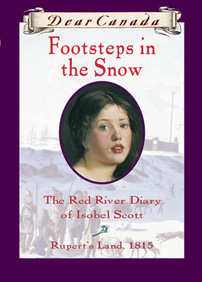 |
Footsteps in the Snow |
Footsteps in the Snow: The Red River Diary of Isobel Scott by Carol Matas, from Scholastic Canada’s Dear Canada Series, provides an opportunity for children to connect more personally to the story of the Selkirk Settlers. From the book jacket we read:
‘Isobel thinks that she and her family will find their fortune in Canada. But Isobel’s mother dies before they even cross the ocean, and other misfortunes seem to follow their every step. Isobel’s family and the other Selkirk Settlers find themselves caught in the fur-trading rivalry between the Hudson’s Bay Company and the North West Company. They cannot even start to build once they finally reach their destination. The harsh climate and escalating threats against the settlers make it impossible to start a new life. Only through perseverance and help from the local Cree band are Isobel and her family able to put down roots in the Red River Valley.’
The novel explores many of the important themes in the Settler’s story including the impact of the harsh winter weather, and the flood of 1826, the Fur Trade Wars and the incident at Seven Oaks. It also explores the evolution of Isabel’s thoughts about the aboriginal people she meets and becomes friends with. Teachers will want to prepare students for the prejudices Isabel expresses at the beginning of the book and help them to discover that as she comes to know the aboriginal people of the Red River, she realizes the falseness of these prejudices.
You may want to do a novel study or read this story aloud to your students. However you choose to use it, Scholastic Canada offers teaching resources to support the novel, including an authors note, art activities, and an interactive time line. Several free downloadable teaching activities are here. For teachers who are interested, a Teaching Guide which develops both social studies and language arts skills can also be ordered.
If you have access to a public library you may be able to find multiple copies of Footsteps in the Snow. The Winnipeg Public Library lists 22 copies. In addition, it has 4 copies of a teachers guide: Teaching with Dear Canada: build important social studies and language arts skills with historical fiction, by Amy Von Heyking.
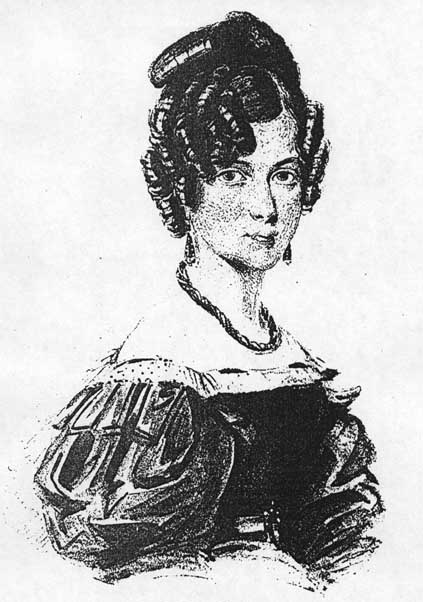 |
Frances Ramsay Simpson
|
An interesting contrast to the fictional diary of Isobel Scott is the real life diary of Frances Ramsay Simpson, the daughter of a London merchant, who married her cousin, HBC Governor George Simpson, in 1830. Excerpts from her diary can be found in Fur Trade Stories, a presentation of Canada’s National History Society. Several diary entries describing her observations of life in the colony and during a long trip by canoe with her husband are bookmarked here. These pages have other interesting features including links to related material, an image of the handwritten diary entry and a ‘did you know?’ box.
Historical articles provide opportunities to develop children’s skills in reading informational text. The Manitoba Historical Society’s series, Manitoba Pageant provides many such texts of varying degrees of difficulty. Teachers may consider using a DRTA strategy to support their students’ reading and listening comprehension.
The Lord Selkirk Settlement at Red River, Parts 1 and 2 by Anne Matheson Henderson (Part 2 can be accessed at the bottom of the page) provides an opportunity to compare the people and events in this historical account with those of the fictionalized historical novel discussed above.
Together these two articles tell the Selkirk Settlers’ story, from the Highland Clearances to Lord Selkirk’s visit to the Settlement in 1817. Many of the main characters are referenced, including Lord Selkirk, Miles MacDonell, Governor Semple and Cuthbert Grant. Many images support the text, including maps of the route from York Factory to Fort Daer, and of the land holding granted to Lord Selkirk by the Hudson’s Bay Company. This article also references many of the most important events, including the roots of the hostility towards the Settlement by the Northwest Company.
A much shorter and perhaps more accessible article is Lord Selkirk Settlers by William L. Morton, published in April 1962. It provides interesting background on the Red River Colony and the Selkirk Settlement, including information about the naming of Point Douglas. It depicts Lord Selkirk’s settlers as distinct from others in the Red River Colony and describes in detail the number of settlers who came and from where. Teachers may want to prepare their students for the reference to half-breeds, a term used to describe people of mixed aboriginal and Scots blood which was an acceptable term to use in the 1960s when this article was published, but is often considered pejorative today.
The Lord Selkirk Association of Rupertsland has another interesting account of the founding of the Selkirk Settlement at Red River. Other links on this site lead to interesting accounts of life in the settlement that may be useful source material for further study. An example is this description of bringing in the hay.
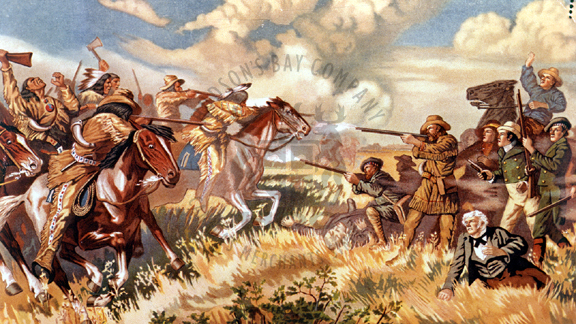 |
Battle of Seven Oaks
|
There is much controversy about the event at Seven Oaks on June 19th, 1816. In the article posted on the Lord Selkirk Association of Rupertsland, tagged above, it is called The Seven Oaks Massacre. But others, as in this book review by David McCrady, view it as a pivotal moment in the birth of the Métis Nation know it as The Battle of Seven Oaks.
In Fur Trade Stories, a group of first person accounts of the event at Seven Oaks present an interesting opportunity to develop children’s understanding of diverse perspectives, a key to historical perspective taking. Children can be encouraged to read and discuss the differences and similarities in each person’s narrative, and to explore the reasons for these differences, perhaps through further research into each of the story tellers.
Both A Visit With The People of the Red River-A Young Person’s Guide and Resource Book and The People of the Red River-A Costume Guide by Barry and Judy MacPherson provide a wealth of visual images and information depicting life in the settlement. As such they are highly recommended for an examination of settlement life through the eyes of artists and historians as well as the first person accounts of some of the Settlers and their leaders.
It is our intention to supplement those resources with on-line activities and information. However, circumstances have necessitated doing so at a late date.
In the meantime a focus on Scottish country dancing allows us to recreate some of what may have transpired in the homes and halls of the settlement during those occasions that drew people together for social celebrations. Indeed, several first person accounts belie, at least somewhat, the stereotype of the dour Scotch Presbyterian sometimes associated with the settlers.
Dancing in the Red River Selkirk Settlement
A focus on dancing allows us to recreate some of what may have transpired in the homes and halls of the settlement when people met for social celebrations. Indeed, several first person accounts belie, at least somewhat, the stereotype of the dour Scotch Presbyterian sometimes associated with the settlers! The 1812 diary entries of Miles MacDonnell, written during the first winter at Fort Daer, reference only reels, the oldest and some would say, most Scottish of dances. The letter written in 1848, however, makes specific reference to country dances, jigs and other popular dances of that period.
The old Scottish reels influenced the development of modern Highland dancing. This dance tradition has however, become largely an athletic sport that is very competitive and is seldom danced as a social activity. In the early days of the settlement it is more likely that the reels that were danced were influenced by country dancing whose influence began to spread from the cities to the countryside, including the highlands in the mid 18th century.
The Red River Jig remains a very popular dance in the Métis dance tradition. It too is thought to have been influenced by European traditions, including the scotch reels, but is also linked to aboriginal Pow Wow dancing. It was very popular in the Red River Settlement, enjoyed by both the Métis and the Selkirk Settlers.
The old reels were also an influence on Scottish country dancing. The Story of Scottish Country Dancing draws this link and describes the evolution of modern Scottish country dancing. Further information about Scottish country dancing is available through Wikipedia.
To celebrate the 2012 Bicentenary, The Winnipeg Branch of the Royal Scottish Country Dance Society has compiled a collection of Scottish country dances for children. These dances were chosen in part because their formations are very old and possibly would have been familiar to the settlers. The dances provide a rich opportunity for collaboration between Classroom and Phys Ed teachers within this study of the Red River Selkirk Settlement.
A description of the dances and copyright restrictions can be downloaded here. Instructions for the dances, including diagrams can be downloaded here. Music for these dances can be downloaded for use by schools for instructional purposes here.
One of the dances in this collection is The Dashing White Sergeant, first published in 1826.
Teachers with some familiarity with folkdance may be able to teach these dances without support. However, fully qualified dance teachers from the Winnipeg Branch of the RSCDS are available to support teachers with dance workshops that can be designed for individual classrooms or larger gym based assemblies of students. Contact information can be accessed through the RSCDS website.
Page revised: 19 October 2011
Copyright © 2011-2015, Bicentenary of the Red River Selkirk Settlement Committee. All rights reserved.
Website created by the Committee for the Bicentenary of the Red River Selkirk Settlement 2012.